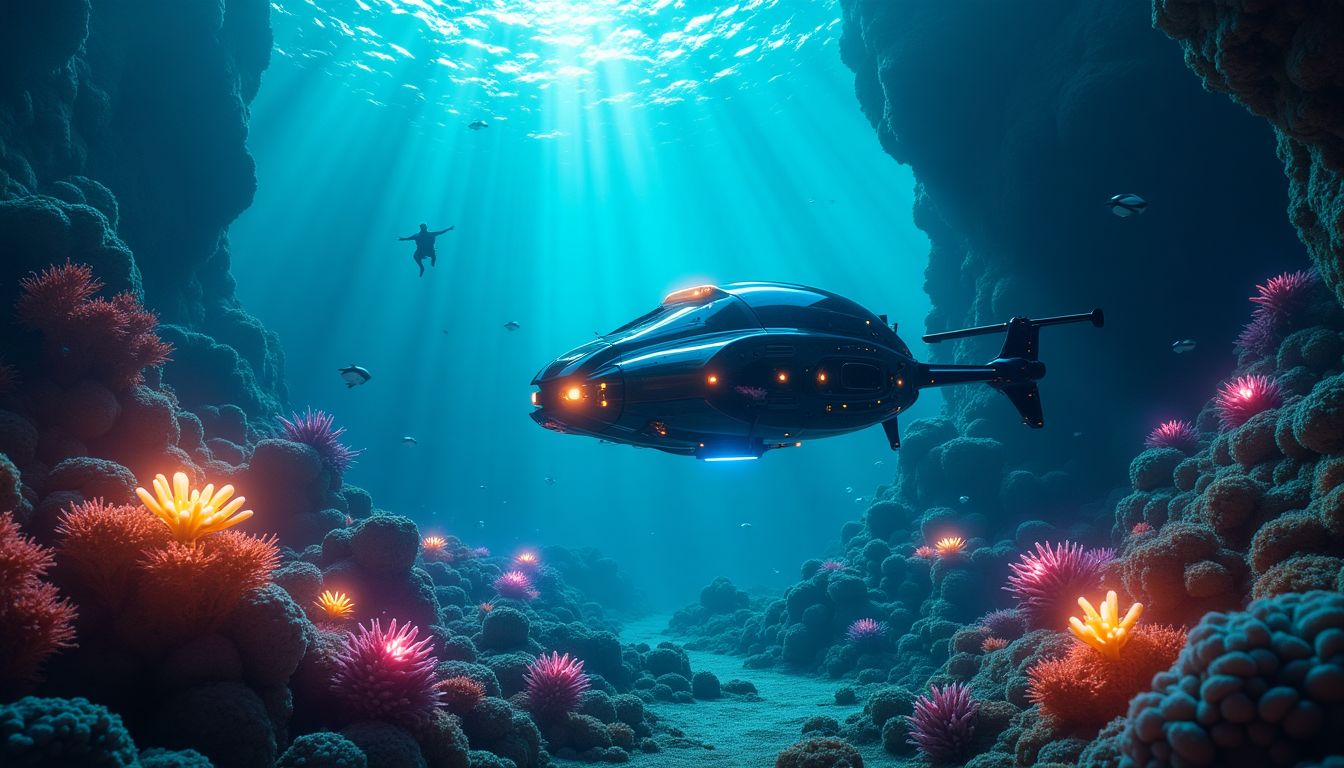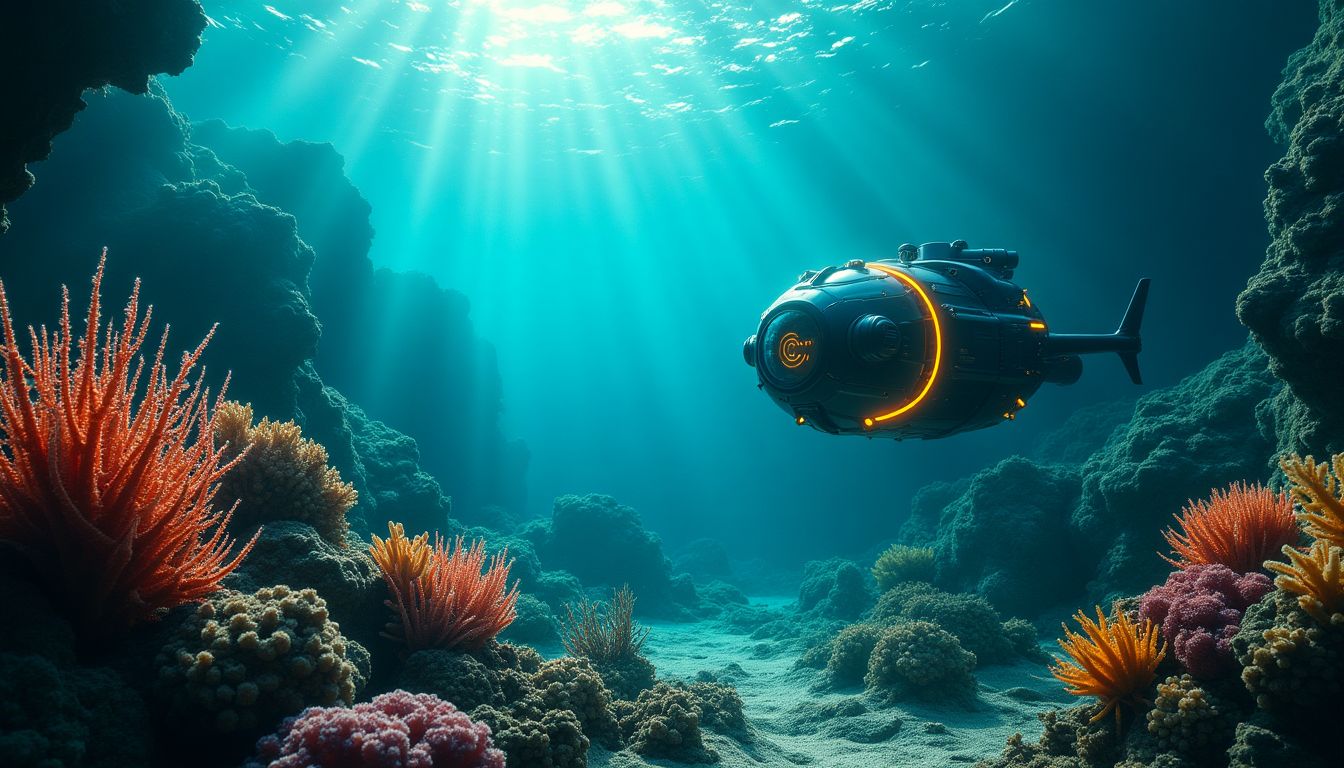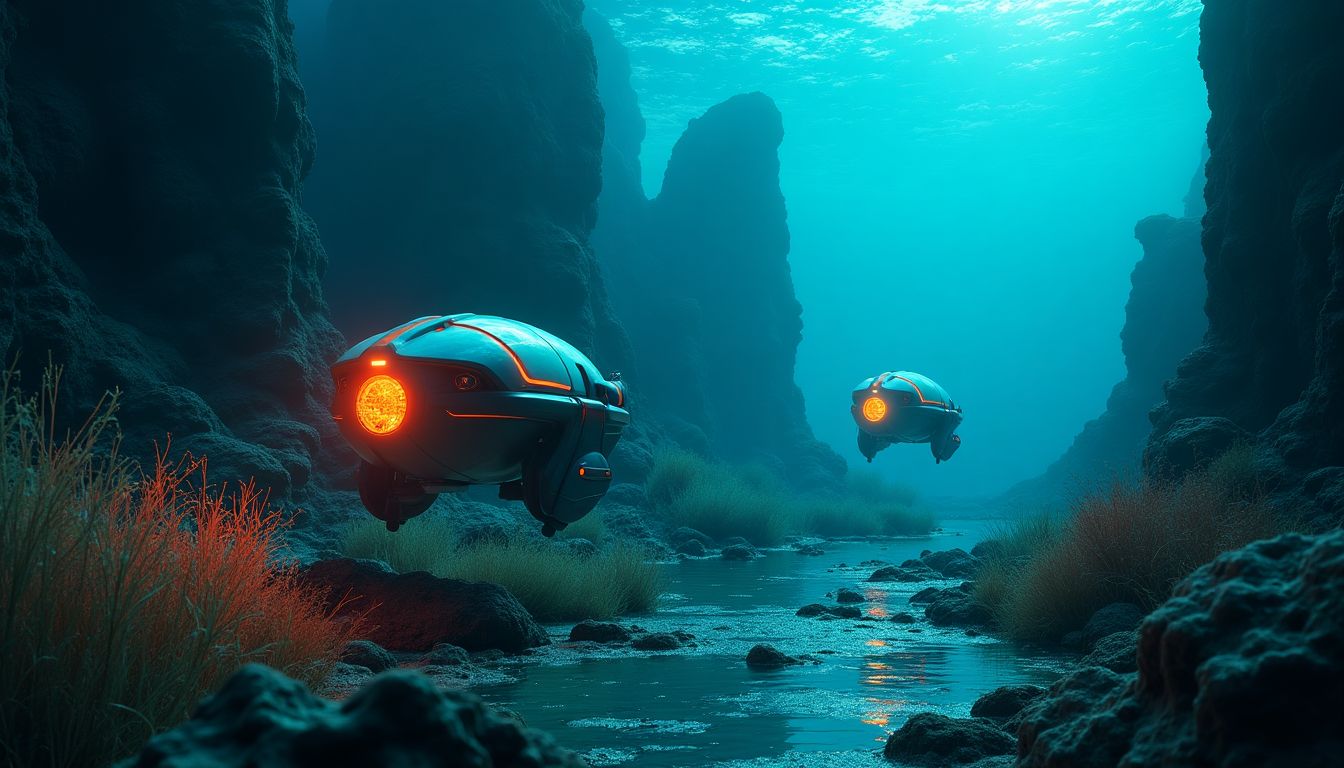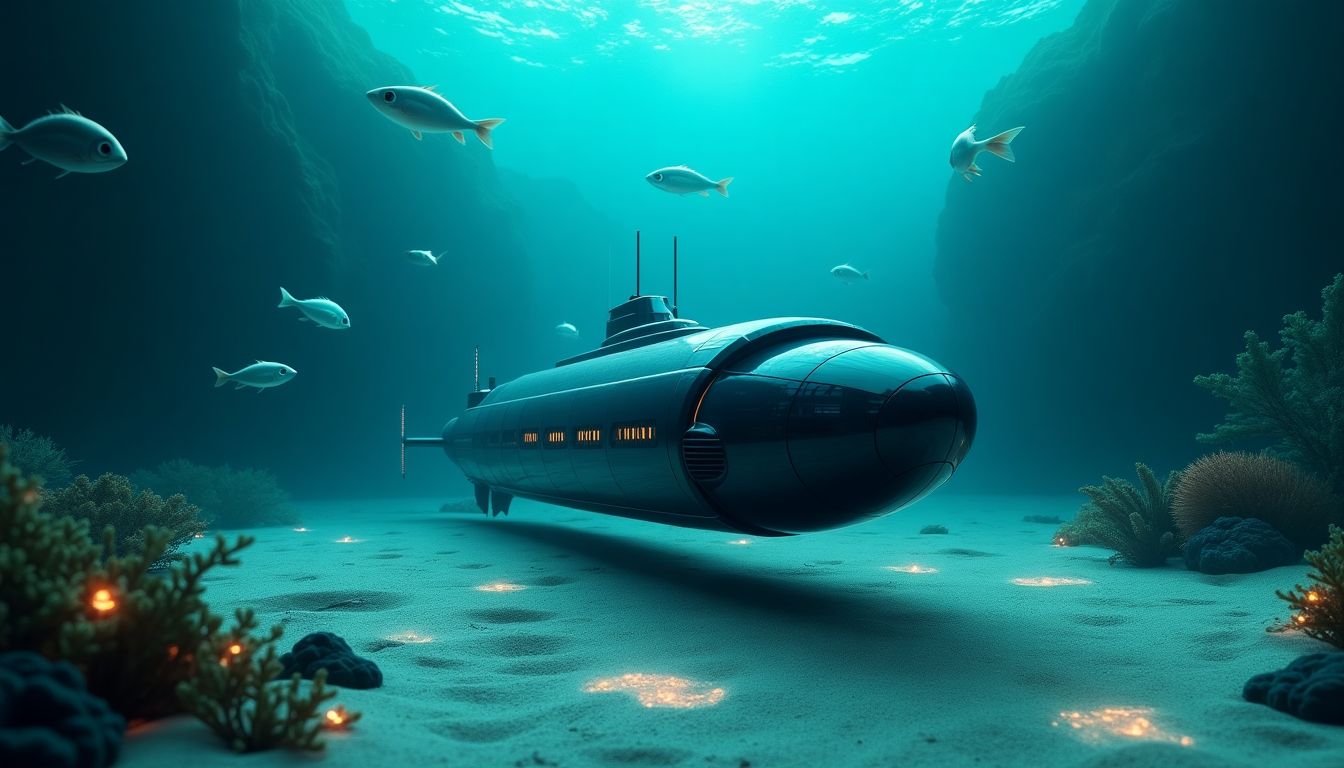What secrets do 95% of our oceans still hold? This isn’t science fiction, and it's not a random trivia night fact either—it’s our reality. Our planet is brimming with mysteries beneath the waves, yet we’ve explored more of the Moon's surface than our own seafloor. It raises an exciting, somewhat existential question: why do we know so little about the deep? With crushing pressures, utter darkness, and chilling temperatures, the ocean floor has humbled humanity's efforts at exploration for centuries—until now. As aspirations move beyond physical limits, minds like Sylvia Earle (Sylvia Earle Wikipedia), James Cameron (James Cameron Wikipedia), and David Attenborough (David Attenborough Wikipedia) have turned toward technology, engineering, and artificial intelligence for answers. Enter the robotic oceanographer—a game-changing innovation poised to do what human hands and eyes cannot: map the uncharted abyssal plains, uncover alien-like species, and discover ecosystems so strange they rival science fiction. Armed with AI, these autonomous underwater vehicles (AUVs) blur the line between science and magic, transforming the daunting depths into accessible data streams. This article will explore not just the marvels these ocean robots could uncover but also the cultural and scientific significance of finally peeling back the veil on Earth's last frontier. Are we ready for what we might find in the deep?
1.1 The Scale of the Unknown
When we say the ocean depths are Earth's “final frontier,” we’re not being hyperbolic. Over 70% of the planet's surface lies beneath water, yet only about 20% of the ocean floor has been mapped at high resolution. Wrap your head around that: vast swaths of our own planet remain as mysterious to us as unvisited planets in solar system lore. One might think the era of blank spots on maps died with the Age of Discovery, but no—those blank spots now sit miles beneath the waves in near-impenetrable darkness. Why? It takes more than courage to explore these depths. Crushing pressures, some exceeding 1,000 times the atmospheric pressure at sea level, make sending human physiologies to these extremes nearly impossible without a fortress of steel, titanium, and insane funding.
Add to this the icy temperatures, limited communication systems, and logistical nightmares that come with traditional deep-sea missions, and you begin to see why exploration has stagnated. Traditional tools, like remotely operated vehicles (ROVs) and sonar mapping systems, have limitations, not the least of which are their overwhelming costs and cumbersome operations. Enter AI-driven robotic submersibles—tools capable not only of lasting longer in these harsh environments but also intelligently navigating challenges without human oversight. The promise they present isn't just incremental progress but a paradigm shift in how we unlock Earth’s aquatic mysteries.
1.2 A Treasure Trove of Life
Why should we care about what's lurking in pitch-black waters? Because those inexplicable deep-sea ecosystems could rewrite everything we thought we knew about life on Earth. Hydrothermal vent systems—first discovered in the late 1970s—turned our understanding of biology on its head, revealing that entire communities of creatures could thrive without sunlight, relying instead on chemosynthesis. Scientists, from work as revolutionary as that of University of Washington emeritus oceanographer Dr. John Delaney (University of Washington: John Delaney), have hinted that such alien-like ecosystems may not just exist but could be abundant. Imagine what else lies undiscovered: bioluminescent jellies, crabs sporting biological armor, or entire new plant families adapted to extremes we barely understand.
Beyond biological intrigue, the discovery of new species could have profound implications for medicine, energy, and even climate science. Deep-sea sponges and corals, for instance, are being studied for compounds with potential cancer-fighting properties. Could life on the ocean floor also give us clues for biotech breakthroughs? Finding answers in the depths might not just satisfy curiosity—it could reshape industries. AI robotic explorers, unshackled by human limits, are the way forward to uncovering these untapped realms of possibility.
2. Challenges of Traditional Deep-Sea Exploration
2.1 Logistical and Financial Barriers
Let’s face it—the deep sea is not your average weekend getaway. The costs associated with traditional exploration methods are astronomical. Take manned subs like DSV Alvin, for example. Operating these iconic vessels can run into tens of thousands of dollars per day. And remember, you’re also paying for skilled personnel, extensive maintenance, and transportation logistics. Manned missions, while spectacular, often feel more like a moonshot than routine scientific research.
Then there are remotely operated vehicles (ROVs), such as Jason, which save lives by keeping humans out of the depths but come with their own financial ceilings. For these remarkable robots to function, extensive surface support is required, including vessels and onboard crews monitoring operations around the clock. And if a single instrument fails? That’s another huge logistical headache—and cost spike.
2.2 Technological Limitations
But it’s not just about dollars and logistics. Our current technologies can’t always keep pace with our imagination. Most of the deep ocean exploration still depends on outdated techniques like multi-beam sonar, which maps the seafloor in patches rather than providing continuous coverage. Sure, it works, but it’s like trying to sketch the Grand Canyon by candlelight—hardly ideal.
Communication is another issue. At extreme depths, acoustic signals struggle to relay fast, meaningful real-time data. The process is slow, fragmented, and results in delays for mission-critical assessment. In essence, this means valuable time is lost hauling instruments to the surface for manual analysis. Progress moves at a crawl—often a literal one.
And here’s the kicker: humans or ROVs only explore tiny snapshots of the seafloor on each mission. If our planet’s searoom were a book, we’ve read less than five pages. What could we achieve if we ditched these design flaws?
3. Enter the Robotic Oceanographer: AI Submersibles
3.1 Engineering Autonomous Underwater Vehicles (AUVs)
Now, imagine if exploration could skip all the pitfalls above. This is where Autonomous Underwater Vehicles (AUVs) come charging in like the protagonists of a sci-fi movie. AUVs, installed with high-tech gear, are designed to dive deeper, stay underwater longer, and collect data more efficiently than any traditional method.
Modern AUVs are equipped with sophisticated tools like LiDAR, high-resolution cameras, sonar systems, and sensors that detect chemical properties in the water. While previous submersibles relied heavily on operators at the surface, these machines are the definition of independence. Thanks to smart navigation software powered by AI algorithms, they can make real-time decisions at a scale impossible for human teams. One second, they’re charting a trench. In the next, they’re identifying an unexpected anomaly. Talk about multitasking!
3.2 Data Processing with AI
Perhaps the most mind-boggling shift comes from how AUVs process data. Traditional tools simply collect information to review later. Not so with AUVs. These robots bring machine learning into the equation, allowing for in-the-moment analysis and smarter operations.
Take marine life identification, for instance. Equipped with algorithms like Convolutional Neural Networks (CNNs), AI systems can immediately classify species captured in video recordings—saving researchers months of manual sorting back in the lab. It’s like having an onboard marine biologist, only faster and more accurate.
Moreover, this real-time capability extends beyond identifying coral or squids. AI can recognize deviations in ecosystems, flagging previously unseen terrains or hydrothermal vents as potential hotspots. Leading organizations like Woods Hole Oceanographic Institution (WHOI) and NOAA already utilize such technologies to expand their reach, but the journey is just beginning.
4. Discovering New Species and Ecosystems with AI
4.1 Deeper and Wider Mapping
Mapping the ocean floor is like piecing together the world’s largest and darkest puzzle. This is where artificial intelligence truly shines. AI-powered autonomous underwater vehicles (AUVs) are capable of surveying vast areas of the ocean at depths previously unattainable by human efforts. Traditional methods, while groundbreaking in their time, pale in comparison to the efficiency and precision these robotic explorers bring to the table.
For instance, let’s look at how robotic oceanographers like those developed by the Monterey Bay Aquarium Research Institute (MBARI) use high-resolution mapping techniques. Equipped with multi-beam sonar, LiDAR, and advanced imaging technologies, AUVs can create detailed, 3D maps of the seabed, uncovering sunken geological features such as seamounts, trenches, and hydrothermal vents. This technology offers more than pretty maps—it helps oceanographers pinpoint ecological hotspots, areas that teem with life and need further study.
As a recent example, NOAA’s initiative to map 100% of the U.S. Exclusive Economic Zone was accelerated by deploying these AI-driven tools. Imagine how such precision can fuel knowledge-sharing between scientific institutions, letting us leapfrog years of slow, expensive expedition missions.
4.2 Life in the Abyss
The ocean’s unexplored depths might as well be a different planet. Underwater habitats like hydrothermal vents or methane seeps are home to biological goldmines. These extreme environments support creatures that defy logic—giant tube worms, bioluminescent jellyfish, and organisms that produce energy through chemosynthesis instead of sunlight.
Using AI, robotic submersibles can identify and catalog unique species on the fly. For example, AUVs can photograph bioluminescent bursts in pitch-black waters and use algorithms like convolutional neural networks (CNNs) to identify organisms emitting these lights. This method has shown particular promise in differentiating species behaviors, such as hunting patterns or reproductive rituals.
AUVs and their on-board AI can also collect environmental DNA (eDNA) samples. Just as crime labs use DNA to identify suspects, oceanographers analyze eDNA shed by marine organisms to track species presence and migration in unseen habitats. This revolutionary technique has already helped researchers discover rare shark species in areas previously thought devoid of large predators.
4.3 The Future of Biodiversity Discoveries
The implications of robotic oceanographers are enormous. Picture an "internet of maps" where scientists worldwide can access up-to-date biodiversity records centralized in open databases like GBIF. The discoveries made with AI don't just sit in academic archives—they ripple outward, impacting medicine, conservation, and even industries like renewable energy.
Key discoveries of unique organisms may:
- Bring breakthroughs in pharmaceuticals (e.g., compounds for cancer treatment).
- Inspire bioengineering, such as materials mimicking deep-sea adaptations.
- Help model climate-resilient ecosystems for long-term sustainability.
The deep sea is, quite literally, brimming with untapped potential. But what are the broader stakes for the world at large?
5. Global Implications of the Robotic Oceanographer
5.1 Conservation and Sustainability
One of the most crucial roles AI-driven oceanography plays is shedding light on habitats under threat. Industrial activities like deep-sea mining and large-scale trawling destroy critical ecosystems, sometimes before we even understand their importance. AI-powered AUVs can change that by providing us with comprehensive, real-time data about vulnerable areas.
Consider the Clarion-Clipperton Zone, a massive seabed between Hawaii and Mexico that’s targeted for mining rare earth metals. This area is home to fragile, slow-growing sponge and coral species that play an irreplaceable role in deep-sea ecosystems. AI submersibles are currently helping researchers evaluate the environmental impact of mining by retrieving high-resolution imagery and biological samples.
When paired with international databases like IUCN’s Red List, AI-driven maps could guide policymakers on creating marine-protected areas (MPAs). The broad goal? Establish ecological boundaries before it’s too late, ensuring that these underwater worlds remain untouched by human greed.
5.2 Impact on Climate Studies
The future of oceanic exploration doesn't just impact marine life; it has far-reaching consequences for how we address the climate crisis. Did you know that the ocean absorbs roughly 30% of human-generated CO2? Or that deep-sea ecosystems could act as carbon sinks, locking away atmospheric carbon for millennia?
Robotic oceanographers are poised to answer some of the biggest questions about how oceans regulate Earth’s climate. By studying undercurrents, thermal plumes, and sediment layers, AI submersibles capture intricate data that feeds into climate models. For instance, analyzing seafloor sediments can reveal historical changes in CO2 absorption patterns over geologic timescales—critical knowledge for future mitigation plans.
5.3 Economic and Social Ripple Effects
Let’s not ignore the broader socioeconomic impacts of harnessing robotic oceanography:
- Equity in Knowledge: By democratizing access to deep-sea data, underfunded scientific institutions in low-income countries could finally participate in Earth’s greatest exploration project.
- Economic Benefits: Job creation and innovation in marine technology sectors, potentially comparable to the space race boom, are on the horizon.
- Revolutionizing Education: Imagine students in Mumbai or Cape Town using live-streamed data from the deepest faults of the Pacific Ocean for school science projects. Accessible knowledge fosters global curiosity and collaboration.
But wait—what responsibilities come with unlocking the deep sea's Pandora’s box? Regulation becomes urgent. Safeguards must be in place before corporations exploit findings for profit, leaving ecosystems damaged in their wake.
5.4 Preparing for Interplanetary Parallels
Astrobiologists are already adapting AUV prototypes for missions to icy moons like Europa and Enceladus. NASA, in collaboration with Ocean Worlds Research, is using these robots to perfect methodologies for extraterrestrial ice-encased waters. But there’s a catch—what if lessons learned from Europa inspire catastrophic developments back on Earth?
While AI offers hope, we can’t lose sight of the need for ethical frameworks guiding exploration. Just as we’ve established rules for space treaties, perhaps we need an "Oceanic Charter" to govern our actions undersea.
As we stand at the crux of human achievement and responsibility, this question looms large: Will AI oceanography make us better stewards of the planet—or accelerate its exploitation?

6. AI Solutions/How Would AI Tackle This Issue?
If the deep sea were a puzzle box, then today’s AI is the Rubik’s Cube genius capable of solving it. Tackling the challenges of deep-sea exploration requires designing machines that can think critically, adapt autonomously, and push the boundaries of what we thought possible in extreme environments. Picture a symphony of robotics where innovation is the composer and AI is the baton, directing every revolutionary movement. Here’s how we break the surface of this enigmatic frontier with artificial intelligence.
6.1 Designing Adaptive Submersibles
The first obstacle is creating AI-powered submersibles that can survive and thrive in the abyss. The stakes are high: pressures exceed 1,000 atmospheres, and temperatures plunge near freezing. Borrowing from advancements in self-driving cars and drones, technologies such as deep reinforcement learning allow underwater vehicles to navigate by constantly analyzing variables like topography, salinity, and underwater currents in real-time. These AI agents continuously evaluate their trajectories, making them capable of sidestepping hazards, like underwater ridges or volcanic vents, without human intervention.
Imagine a robotic diver kitted out with multi-material hulls inspired by the exoskeletons of deep-sea crustaceans, reinforced with flexible polymers capable of withstanding oceanic abyssal conditions. Paired with AI, this isn’t just exploration—it’s survival engineering powered by machine learning. A prime example would be AI-developed prototypes like Stanford University’s OceanOneK, which mimics human dexterity and autonomy in otherwise hostile environments.
6.2 Learning-from-Data Mechanisms
Where traditional submersibles collect data to analyze post-mission, AI submersibles operate like an underwater detective working the case in real time. Machine learning models, such as Generative Adversarial Networks (GANs), enable these robotic systems to adapt dynamically. For instance, while surveying unknown seamounts, an AI can spot a biophysical anomaly—say, a microbial mat emitting unusual fluorescence—generate synthetic hypotheses on the fly, and quickly adjust its mission objectives to investigate further.
This self-updating mechanism essentially allows the vehicle to become an autonomous learner, continuously optimizing its understanding of marine ecosystems. By linking its onboard AI to cloud-based research databases (secured via partners like OpenAI or Google DeepMind), the submersible can cross-validate findings and distribute updates to scientific collaborators worldwide.
6.3 Scalability via AI Collaboration
The ocean is vast, and no single robot—no matter how intelligent—can conquer it alone. Enter AI swarming, a strategy already proven effective in aerial and ground-based autonomous vehicles. A fleet of AI-enabled submersibles could communicate through underwater acoustic modems, sharing discoveries, cross-checking data, and distributing tasks. Each submarine becomes a node in a neural network, akin to the hive-mind intelligence seen in ant colonies but designed for exploration.
Imagine a scenario where Robot 1 maps a thermal vent, Robot 2 identifies heat-resistant microbial strains nearby, and Robot 3 analyzes chemical emissions—all in concert. This is not a pipe dream: distributed systems like NASA’s SWARM Initiative make this prospect attainable on Earth before we test it on moons like Europa.
6.4 Action Schedule/Roadmap
Building a successful deep-sea exploration framework requires thoughtful assembly, funding, and collaboration. Here’s a roadmap inspired by historical mega-projects like the Manhattan Project and modern-day technology.
- Day 0: Register a domain, such as ProjectAbyssAI.com, as a public-facing website showcasing goals, funding progress, and real-time discoveries.
- Day 1: Convene a steering committee featuring experts from organizations like NOAA, MBARI, and tech leaders like Tesla.
- Day 2: Secure commitments from artificial intelligence leaders DeepMind, IBM Watson, and robotics firms like Boston Dynamics.
- Week 1: Establish computational clusters using OpenAI’s resources linked to high-scale GPU farms.
- Week 2: Announce a global challenge inviting universities like MIT, Harvard, and Oxford to co-author an initial white paper.
- Month 1: Prototype a modular AUV for shallow-water testing, integrating open-source AI systems for navigation and anomaly detection.
- Month 2: Secure international maritime research permits under the UN Convention on the Law of the Sea.
- Month 3: Begin sea trials of Phase-1 AUV units equipped with chemical sensors in the Sargasso Sea.
- Month 6: Deploy a fleet of pre-commercial models in collaboration with academic institutions such as the Scripps Institution of Oceanography.
- Year 1: Public release of findings, including the identification of at least one unknown species or ecosystem type.
- Year 2: Scale to global exploration operations, establishing a permanent AUV network capable of monitoring seismic activity, biodiversity hotspots, and resource-rich zones sustainably.
The Future Lies Beneath the Waves
For centuries, the ocean has been a metaphor for the unknown—vast, daunting, and immeasurably complex. Yet, as humanity stands on the brink of profound ecological and technological revolutions, it’s the unknown that holds the keys to our survival. The robotic oceanographer is more than a tool; it is an emblem of our unyielding curiosity and innovation. With over 95% of Earth’s oceans still uncharted and teeming with secrets, the potential for discovery is limitless. Each AI-guided dive becomes a brushstroke on the world’s greatest canvas, painting a picture of life’s resilience, evolution, and interconnectedness.
Still, the rise of autonomous undersea explorers isn’t without challenges. How do we ensure these discoveries serve humanity and not just profit? Will the pursuit of the ocean’s resources jeopardize its fragile ecosystems? These questions aren’t rhetorical—they demand action, transparency, and collective responsibility. Yet history suggests that our better angels and our scientific ingenuity can strike that balance.
So, as robotic divers light up the abyss with sensors and algorithms, the question shifts. Is global society willing to match their curiosity, courage, and drive? Perhaps our answers aren’t confined to the seafloor—they're a reflection of what lies within us, waiting to explore, illuminate, and understand. Dare we dive deeper?
Let’s talk: What excites you most about AI in deep-sea exploration? What risks concern you? Share your thoughts below. Don’t forget to subscribe to our newsletter and join the mission. At iNthacity, the ‘Shining City on the Web,’ groundbreaking innovation begins with you.
FAQ: Everything You Need to Know About Robotic Oceanographers
1. What exactly is a robotic oceanographer?
A robotic oceanographer is an autonomous underwater vehicle (AUV) powered by artificial intelligence (AI). These robots are specifically designed to explore, study, and map the deep sea, often going where humans or traditional submersibles cannot. Think of them as the ocean’s equivalent to NASA’s rovers on Mars, but instead of red dirt and rocks, they navigate through dark waters filled with strange creatures and unknown ecosystems. These AUVs use advanced tools like sonar, LiDAR, and machine learning to process data in real time.
2. Why can’t humans just explore the ocean themselves?
Good question! While humans have technology like manned submersibles DSV Alvin or remotely operated vehicles (ROVs), these methods come with several challenges. Deep-sea pressures are over a thousand times stronger than at the ocean’s surface, making human exploration dangerous and expensive. Not to mention, manned submersibles often require massive support teams, ships, and specialized equipment. In comparison, robotic explorers can dive deeper, stay underwater longer, and operate more cost-effectively without putting anyone in harm’s way.
3. What makes robotic oceanographers so special?
Great question! Unlike traditional tools, robotic oceanographers are equipped with cutting-edge AI and can "think" for themselves. They analyze their surroundings in real time, adapt their missions on the go, and even identify new species or underwater anomalies. For example, robots like those developed by the Monterey Bay Aquarium Research Institute (MBARI) use computer vision to classify marine organisms or detect deep-sea geological structures without needing humans to guide them.
4. What kinds of things could we discover in the deep ocean?
The possibilities are mind-blowing. Here’s just a peek into what robotic oceanographers could uncover:
- New Species: Scientists believe the majority of Earth’s species live in the ocean. We’ve already discovered alien-like organisms around hydrothermal vents.
- Geological Formations: This includes underwater mountains, trenches, and volcanic activity.
- Medical Insights: Marine life could lead to breakthroughs in medicine, much like how coral has contributed to bone grafts.
- Clues to Extraterrestrial Life: Studying deep oceans may help us understand the conditions for life on planets like Europa, one of Jupiter’s moons.
5. What technologies do robotic oceanographers use?
Robotic oceanographers are packed with features. Here’s a breakdown:
| Tech Feature | Purpose |
|---|---|
| Sonar | For mapping the ocean floor and detecting objects underwater. |
| LiDAR | Creates high-resolution, 3D images of underwater environments. |
| AI Algorithms | Processes data in real-time and identifies patterns or anomalies. |
| Chemical Sensors | Analyze the water for signs of life, pollutants, or temperature changes. |
| HD Cameras | Capture visuals of marine life and habitats. |
6. How does AI make these robots smarter than traditional tools?
Artificial intelligence allows robotic oceanographers to process and analyze data as they collect it, unlike older methods that require data to be reviewed post-mission. For instance, machine learning algorithms such as convolutional neural networks (CNNs) are used to identify fish, coral, or geological formations from visual data. Looking for bioluminescent lifeforms? AI can distinguish glowing organisms from environmental light reflections. This kind of real-time adaptability makes AI-powered tools a game-changer.
7. Aren’t there risks to using robots in the ocean?
Yes, no technology is perfect. Here are a few potential risks:
- Environmental Impact: Robots could unintentionally disturb marine ecosystems.
- Ethical Concerns: Data collected might be used for exploitative industries like deep-sea mining, which harms biodiversity.
- Algorithmic Bias: AI could miss crucial findings if it’s not trained with diverse data.
To address these risks, oceanographic institutions like NOAA are implementing transparent protocols and eco-friendly designs.
8. Are there companies or organizations developing these robots?
Absolutely! Several players are leading the charge in underwater robot technology:
- Woods Hole Oceanographic Institution (WHOI)
- OceanX
- OpenAI (partnering for AI innovations)
- MBARI
9. How soon could we fully map the ocean with these robots?
If funding and international collaboration align, experts predict significant strides within 20 years. For example, ongoing initiatives like Seabed 2030 aim to map the entire seabed by 2030 using advanced technologies, including autonomous robots.
However, covering all Earth’s oceans in exhaustive detail will likely take longer, given their sheer size and complexity.
10. Why is this important for humanity?
Exploring the ocean isn’t just about satisfying curiosity—it directly impacts our lives. Understanding deep-sea ecosystems can reveal solutions for climate change, biodiversity conservation, and new medical advancements. The ocean drives our weather patterns, supports global fisheries, and stores vast amounts of carbon. Without fully grasping its role, we risk mismanaging resources essential for our survival.
Ultimately, robotic oceanographers give us a once-in-a-lifetime opportunity to illuminate Earth’s final frontier and safeguard its riches for future generations.
Wait! There's more...check out our gripping short story that continues the journey: On the Shifting Cobalt Seascape
Disclaimer: This article may contain affiliate links. If you click on these links and make a purchase, we may receive a commission at no additional cost to you. Our recommendations and reviews are always independent and objective, aiming to provide you with the best information and resources.
Get Exclusive Stories, Photos, Art & Offers - Subscribe Today!




























1 comment